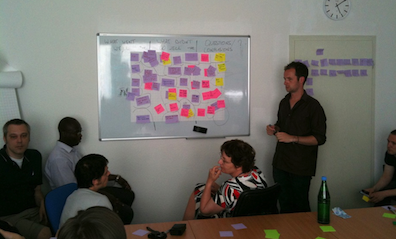
7 Step Agenda for an Effective Retrospective
For a while we (Paulo Caroli and TC Caetano) have been cataloguing many ideas and activities for retrospectives. We’ve created a 7-step agenda with steps and activities to help you to structure your next retrospective.

Agenda structure:
1. Setting the context
Setting the context at the beginning of any meeting is the first step you can take to ensure that the meeting is effective. Participants need to understand what the focus of the meeting is.
You can start the meeting either with a pre-defined context, or you can define it real-time with the participants (“So, what is the context for this retrospective?”).
Below are some sample contexts:
- “This retrospective is a bi-weekly recurring Scrum retrospective for the ABC team. We are on Sprint 12 out of 30.”
- “In 14 days, our artifact should reach the main production stage.”
- “Feature XYZ exploded in production, bringing the servers down for 2 hours until sys-admin could bring the older version back up.”
- “This team will work together in a new project starting today.”
- “We have worked together in the past year. We will be working together for another year to come.”
2. Prime Directive
In Project Retrospectives, Kerth introduced the “Prime Directive”; a statement intended to help set the stage for the retrospective. The Prime Directive states: ‘Regardless of what we discover, we understand and truly believe that everyone did the best job he or she could, given what was known at the time, his or her skills and abilities, the resources available, and the situation at hand.’ The statement is invaluable to set the tone for the meeting.
3. Energizer
The Energizer is an optional activity that can be run to “warm up” the team and promote group interaction. It is a good meeting starter for any team meeting, and is especially valuable for early stages of team building.
You should select an icebreaker activity to best suit your team’s dynamics. When building teams, we recommend activities that focus on sharing information, such as names and hobbies. Icebreakers can also be used before any meeting, to invigorate the participants and make them feel more engaged.
This kind of activity helps to create a friendly environment and makes people more comfortable to participate in the activities that will follow.
Check out some suggestions for Energizer activities.
4. Check-in
Check-in activities gather information such as gauging the participants’ frame of mind and how they feel about the given context. It is a good next step after setting the context and reading the prime directive, especially as it narrows down the themes that will be discussed later.
Another benefit of doing a check-in is that it helps people to put aside their concerns and then focus on the meeting at hand. Depending on the activity, it also helps if participants put aside their judgments – at least for the duration of the meeting. These are usually short activities. Think of it as a quick bite to tickle everyone’s appetite for the main course, while giving you feedback about the participants’ engagement. Check out further Check-in Activities here
5. Main course
The main course is the core of a meeting that seeks to foster continuous improvement. It is composed of one or more activities, and is also the time for the team to discuss their notes.
The main course activities are used to gather data, check on the team’s morale, talk about the positive stuff, recognize people, and seek improvements. They drive the team to reflect about the given context, reinforce a shared vision and generate insights. The main course is the time for team members to feel heard. Each and every individual note is acknowledged and is visible to the whole team.
Teams that have retrospectives as a recurring meeting will typically look for main course alternatives. By varying the activity, the team can look at different angles and perspectives, therefore generating new insights.
Choose your main course wisely, with the participants and purpose in mind. This is the main activity of your meeting, and in all likelihood, the information gathered and discussed will set the tone for continuous improvement.
6. Filtering
After the main course, you will have a lot of data in front of you. It is important to have well-defined criteria to decide what will be discussed. Given the meeting’s limited time, it is possible that topics will be left out of the discussion.
Some activities might help you to define your filtering criteria. For example, the team may group notes based on similarity and then discuss the identified clusters. Another possibility is to vote, and then focus on the most-voted topics. We've listed some more Filtering Activities here.
7. Next steps
The meeting is almost over. The team had a great discussion and generated many insights. Perhaps the activities have resulted in a few actionable items. This list of “next steps” is the last step in our meeting agenda. There are no formulae or specific activities for it. We recommend that the whole group talk openly about what’s next for the team. What will they do with the findings from the meeting?
A few examples are to include new items to the team’s backlog of work, email the meeting notes to the team, schedule (or remind everyone about) the next meeting.
Check out further resources for your Agile project management, tracking and planning needs
Disclaimer: The statements and opinions expressed in this article are those of the author(s) and do not necessarily reflect the positions of Thoughtworks.














